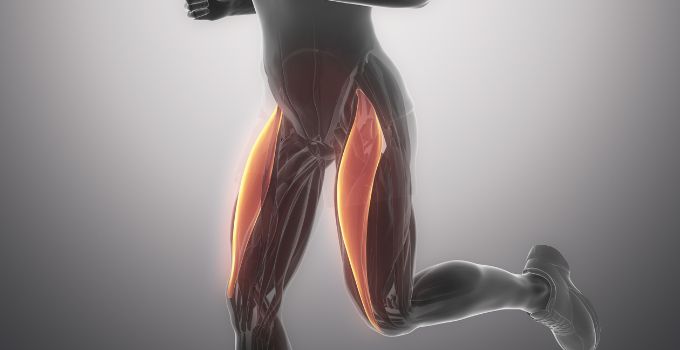The rectus femoris is one of the main muscles outside your thigh. There are multiple types of muscle, but this article focuses on the rectus femoris stretch and how you can use it to improve your flexibility.
Rectus Femoris Explained

The rectus femoris is a long, thin muscle that runs from the hip to the knee and forms part of the quadriceps (or four-headed muscle).
The rectus femoris is one of the body’s largest, most powerful muscles. It has two heads, separated by a tendon, and attaches to two points on either side of the pelvis. The muscle’s primary function is to flex your hip joint and thigh.
It has two heads, called vasti, and two tendons that attach to the patella (kneecap), which is cartilage at the front of the thigh bone.
The rectus femoris extends from the pelvis to just below the knee joint. It then carries most of its weight on the outer edges of your thighs, making it one of your strongest muscles.
The rectus femoris is a powerful hip extensor (a muscle that moves a joint). It helps us extend our hips when standing up from sitting or lying down. When we do this, our leg straightens out, which causes us to rise up on our toes (the big toes). This movement is called toeing off and is necessary for us to get up without falling backward.
Related Article: Pancake Stretch For Beginners
Why Do You Have Rectus Femoris Pain?
You might have pain in the rectus femoris if you have an injury to this muscle or if it’s tight and causes pain when you try to straighten your knee. The rectus femoris can also become tight from overuse – for example, running or jumping too much.
When this muscle gets tight, it can cause pain in your hip joint and lower back. Tightness in the rectus femoris can also lead to a variety of other symptoms, including:
- Lower-back pain
- Shooting pains down your leg
- Tightness in your groin or bottom
- Pain when sitting for long periods
Recommended Rectus Femoris Stretch Options
Many different stretches can be done to reduce pain in the muscles of your thighs. Here are my top four recommendations:
Kneeling Hip Flexor Stretch:
- Stand up straight with your feet together.
- Gently bend forward at the hips, keeping the spine neutral and aligned with the rest of your body.
- Keep your chest high and shoulders back as you reach the floor with both hands.
- Press firmly into both knees as you lean forward, stretching through the front of your hip joints.
- Hold for 15 seconds, then repeat three more times.
Standing Knee Bend Stretch:
- Stand with your feet hip-width apart and the toes of your left foot pointed to the side, bend at your hips, then place the top of your right foot on top of your left thigh.
- Grab hold of your shin with your left hand and gently pull it toward you as you straighten out through your hips.
- Keep both knees slightly bent as you continue this stretch.
- Hold for a few seconds, then switch sides and repeat.
Side-Lying Hip Flexor Stretch:
- Begin lying on your side with one leg straight.
- Bend your top knee, keeping the lower leg flat on the floor.
- Pull your top knee toward your chest, then reach for it with your bottom arm until you feel a stretch in the front of your hip.
- Hold for several seconds, then switch sides and repeat.
Hip Flexor Stretch Lying Down:
- Lie on your back, your knees bent, and your feet flat on the floor. Your arms can be in any position, but make sure they are straight and relaxed.
- Flex your knees toward your chest.
- Hold for 30 seconds, then repeat 3-5 times.
Rectus Femoris Exercises
Remember that stretching the muscle is half of the solution, you need to strengthen the muscles as well.
These are the best exercises we suggest to strengthen your rectus femoris:
Squats: Squats are one of the best exercises to strengthen your rectus femoris. They work your quads, glutes, and hamstrings. You can do them with a barbell or dumbbells.

Lunges: Lunges also work your quads, glutes, and hamstrings, as well as your core muscles. They are also a great way to decrease stress on your knees.

Leg Extensions: These are other excellent exercises for strengthening your quadriceps muscles. They also help build up the strength in your lower back. Leg extensions can be done lying on the floor or standing against a wall for added resistance.

Step-Ups: Step-ups are another excellent exercise for strengthening your quadriceps muscles and building up the strength in your lower back. Step-ups can be done standing up against a wall or sitting on a bench while holding onto something sturdy (like a chair).

Final Thoughts
If you really want to increase your mobility and flexibility, make sure to stretch your muscles but strengthen them as well.
Rectus Femoris is a key muscle you need to watch out for to avoid injuries.
Make sure to create habits and improve consistently. Baby steps are a great way to achieve your goals.